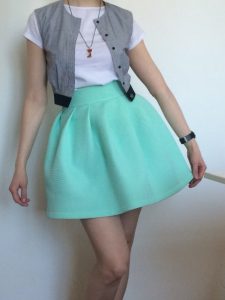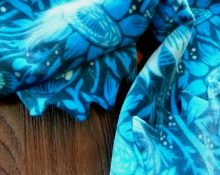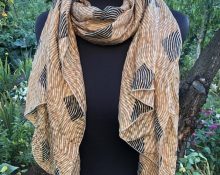
creativecommons.org
Neoprene has gained popularity due to its lightweight structure and ability to resist water penetration. In this material we will tell you how to sew a neoprene skirt with your own hands at home according to the given diagram describing the process. At the end of this article there is a visual pattern for beginners and photos with examples.
What is neoprene?
Neoprene is a honeycomb-like porous fabric that is waterproof. Most often, this fabric is made from artificial rubber fibers. Due to its waterproof properties, this fabric is actively used for sewing wetsuits, as well as protective covers and cases for technical devices. Some neoprene fabrics are formulated with cotton, polyester or spandex, depending on the characteristicsAnd want to receive. Sometimes petroleum products are used to make some subtypes of neoprene.
The history of neoprene
Neoprene was invented thanks to the experiments of the American chemist Wallace Carothers in 1930, who immediately patented his invention under the name... duprene. It was assumed that neoprene would act as an analogue of rubber. However, when working with the material, the smell of neoprene was even stronger than the smell of rubber, and the material was not popular among technologists for a long time. However, in 1953, chemists managed to solve the odor issue - and neoprene began to be actively used in industry. Thanks to various additives, neoprene can change its properties and texture, which gives it a wide range for use both in industry and in everyday life. Wetsuits and suits for scuba divers are made from neoprene; specialized sports suits, as well as dresses and coats, are also made from this material. Today, neoprene is produced in most European countries, including Russia, France, Italy and Germany.
Properties of neoprene

creativecommons.org
The first property of neoprene, thanks to which it became popular in use, is his water-repellent properties. Another advantage for the material from the point of view of technologists was the wide temperature range in which the material can be used without deformation: neoprene can withstand changes from -55 to +90 degrees. However, some subspecies of this materialA have even broader characteristics. Despite its synthetic composition, neoprene is hypoallergenic and retains heat. It is also difficult to accidentally damage due to the high elasticity of the fibers. All these characteristics provide products made from all subtypes of neoprene with a relatively long service life, subject to the rules of fabric care.Due to different additives, neoprene material can vary significantly in appearance and density. Thus, three types of neoprene are distinguished: sportswear is made from soft neoprene, thick suits for hunters and cyclists are made from medium-density neoprene, suits for deep-sea divers and even firefighter suits are made from high-density fabrics.
Neoprene is ideal for sewing tracksuits, as it is quite elastic and can withstand intense loads. And the light shine of the fabric makes it more presentable.
How to care for neoprene products
Products made from neoprene are comfortable to wear, and care for the fabricyu it won't be much work. It is recommended to wash all neoprene items by hand, this will extend the life of the suit. The temperature should not exceed 30 degrees. Experts recommend using liquid soap or soft washing gels as cleaning agents. You should not dry neoprene products on a radiator, as this may cause the shape to become deformed and the material to lose its density.
Dry products in a well-ventilated area. Do not allow exposure to ultraviolet rays, and should not be dried on a radiator or other artificial heating devices. Things may change shape and lose their rich color. The advantage of neoprene is that it does not need to be ironed; the fabric restores its shape on its own.
What you need to sew a neoprene skirt
Neoprene is very rarely used to make clothes for every day. The mostAnd popular products areYuThere are sports uniforms for amateurs and professional equipment. However, among the everyday items made of neoprene that have become fashionable, we can highlight neoprene skirts, which You can sew it with your own hands relatively easily. For sewing you will need:
- A piece of neoprene fabric. It is best to choose plain fabrics in neutral shades, so you don’t have to adjust the pattern and think for a long time about what to wear the skirt with.
- Sewing supplies (thread, needles, pins, ruler or measuring tape, chalk for marking etc.).
- This article presents a pattern with which you can adjust the skirt to the parameters of your model.
Step-by-step master class on sewing a neoprene skirt
With proper concentration on the process, sewing a skirt should take you a little over an hour. This product is one of the easiest to sew, including because due to the ductility of the fabric, there is no need to sew in a zipper or sew on fasteners.
- Build a pattern based on the model parameters, for which you are sewing a neoprene skirt. RWe recommend leaving additional margin for length.
- Fasten the fabric to the pattern and retreat 1.5 cm for subsequent finishing of the edge (in the case of neoprene, the issue of finishing the edge of the product is optional). Cut out the required number of pieces - fragments of the “bell” of the skirt.
- Place them in pairs with right sides facing inward and sew one side together.
- Repeat the steps with the two resulting fragments.
- Repeat until you have one single piece of fabric consisting of 5-7 small ones.
- Machine stitch or sew a neat seam along the top of the skirt.
- Try the skirt on yourself.
- You can sew two parts of the skirt together to create a single piece.
- If desired, you can decorate the bottom of the neoprene skirt with a longer petticoat made of a single layer of mesh, decorated with satin ribbons.


 0
0





